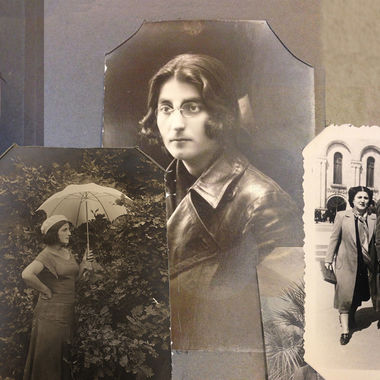Sun Sep 15 2019 · 10 min read
From the Forgotten Pages of History: Margarit Babayan, Her Music, Her Passion and Komitas

By Arpine Haroyan
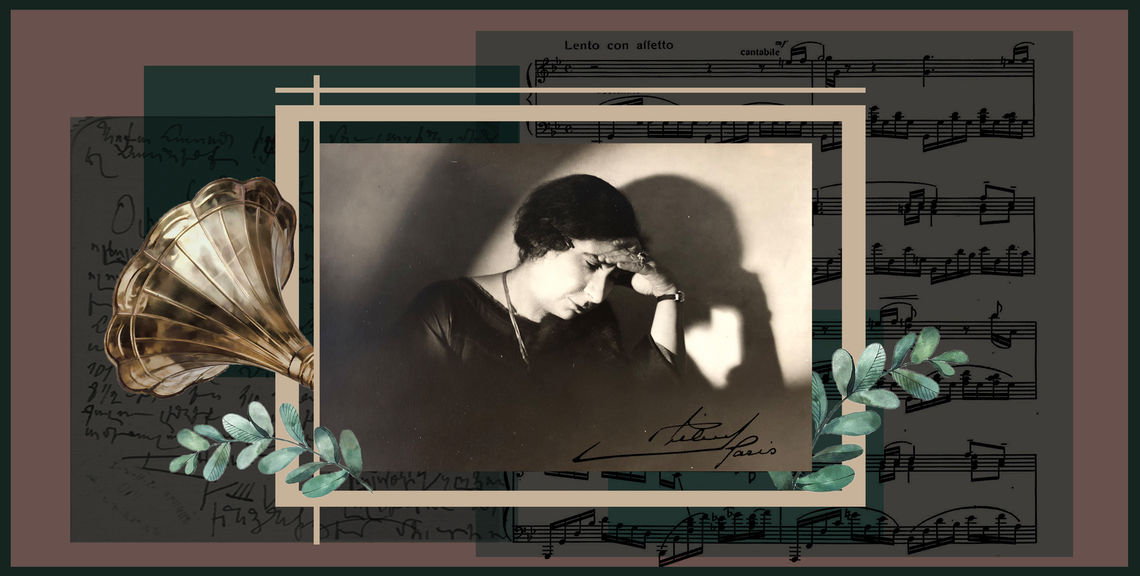
Life and Activities
Margarit Babayan was born in 1874, in Gotha, Germany, into a family of intellectuals. Avetik Babayan, Margarit’s father, originally from Alexandrapol, was a famous doctor in the Caucasus and author of several books about healthcare and public life. Margarit’s mother, Sofia Babayan was an educator and a public figure, known as the founder of the first kindergarten in Tbilisi in 1880.[1]
Along with her two sisters, Shushanik and Armina, Margarit was raised in 19th century Tbilisi - the cultural and educational center of Armenians at that time. From an early age, the Babayan sisters were surrounded by music and the arts. Sofia Babayan spared no effort to discover the talents of her daughters and ensure that they receive a proper education. Years later, Margarit would become one of the most famous mezzo-sopranos in Paris, Shushanik would excel in piano, and Armina would be described as one of the most subtle and noble painters of Paris. [2]
At the age of six, Margarit was already playing piano. She initially studied at the Tbilisi Music College, and then moved to Dresden, Germany to continue her piano classes. However, Margarit soon realized that playing the piano was not enough for her; she decided to train in singing and moved to Paris to continue her education under the guidance of French professionals.
During her studies, Margarit was writing articles about music and various performers for several Armenian magazines and newspapers such as “Ardzagank,” “Mshak,” as well as for the Russian “Caucasus,” and “Novoe Obozrenie” under the pseudonym Enve. In 1896, 22-year-old Margarit published the Armenian version of Victor Wilder’s “Beethoven” - a study dedicated to the life and activities of the famous German composer.
After finishing her studies she returned to Tbilisi and started to perform in various cities in the Transcaucasus as a mezzo-soprano and a pianist.
In 1901, she was invited to teach vocals at the Tbilisi Music College. During this period, Margarit was already a well-known singer in the Transcaucasus, and her performances were being widely discussed in various media. [3]
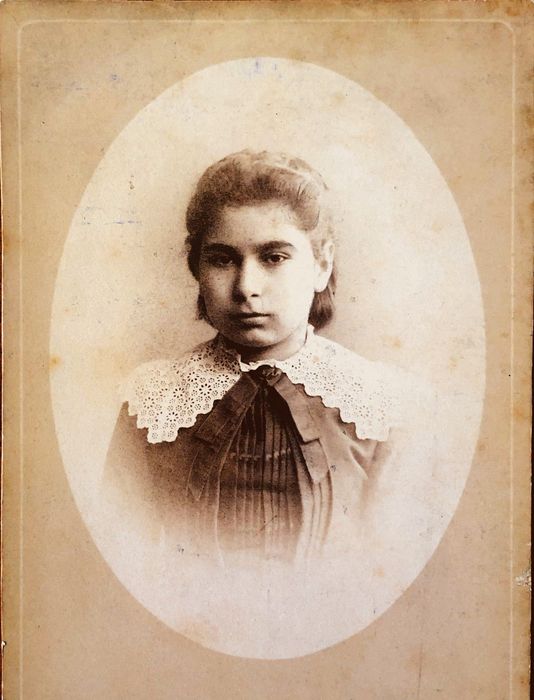
Margarit Babayan as a schoolgirl in Tbilisi,1880s .
Margarit and Komitas
Margarit and Komitas met on several occasions starting in 1895. However, their friendship blossomed after 1902. They were two devoted patriots who were in love with music, and together, became the unofficial ambassadors of Armenian music.
In 1904, the Babayans moved to Paris. The three talented sisters needed to live somewhere where art and culture were thriving. For an already established and talented singer like Margarit, trained by French and German musicians, it did not take long to enter the musical season of 1900s Paris. Soon she became a well-known singer in Paris, where at the time, the key figures in music were French composers such as Claude Debussy, Maurice Ravel and many others.
During this period Komitas was residing in Etchmiadzin, but the distance did not deter him and Margarit from staying in close touch and working together on promoting Armenian music. For several years, they wrote dozens of letters to each other, relaying various events, the political situations in their countries, they exchanged ideas, and discussed musical compositions.
Initially, their relationship was formal and quite professional. The first surviving letters dating back to 1905, show Komitas and Margarit working together on the publication of a book of Armenian songs. However, as their friendship grew, their letters became more personal and intimate. Soon Komitas’ “Honoured Ms. Babayan,” in the beginning of his letters transformed into “Dear Ms.Babayan,” and then into “Dear Margo,” and sometimes even just “darling.” Margarit also put aside the formality and started calling him “Hayr Surbik,” (Hayr Surb means Holy Father, a term referring to Armenian clergy; Margarit added a diminutive suffix “ik” showing her intimacy to Komitas).
Komitas used to tell Margarit about his worries, he complained about the Church and shared with her his dreams and future plans. Although only a few letters survived from Margarit, Komitas’ responses reflect her caring and loving character; she was a beloved friend always ready to support and comfort him no matter the distance.
In 1906, Komitas decided to travel to Europe and earn a living there. Initially, he settled in Berlin and several months later moved to Paris. Being in Paris was a unique opportunity for Komitas to see Margarit more frequently: they would attend concerts and operas together and most importantly, organize concerts and introduce Armenian music to the French public. Together they founded a choir comprised of Armenian and French singers; Komitas became the conductor and Margarit performed as a soloist. Shusanik, Margarit’s sister, was the pianist of the choir.
On December 1, 1906, they gave a big concert of Armenan music in Paris that was long remembered by the French public. “Many famous musicians and singers would later tell me their impressions and would note that they had never experienced such deep musical excitement like in that concert,” wrote Margarit in her memoirs.[4]
In 1907, Komitas left Paris. After performing in concerts in Switzerland, he returned to Etchmiadzin and then, in 1910, moved to Constantinople. For about four years, he and Margarit did not see each other but they found comfort and happiness in long letters they sent to each other from different parts of the world.
During this period, Margarit was actively cooperating with Arshak Chobanian, an Armenian writer and journalist originally from Western Armenia. They would give concerts together where Chobanian would lecture on Armenian music, and Margarit would perform. She was quite passionate about learning and discovering music of different nations and soon she became known for singing forgotten folk songs of different nations. She would sing in Spanish, Greek, Hebrew, Russian, and Armenian. Margarit was also the first performer of French composer Maurice Ravel’s “Five Greek Songs.”
In 1911, Margarit opened a vocal school. While she was busy with her students, Komitas was in Egypt, giving concerts with his newly established choir. After a three-month long tour, he decided to surprise Margarit and visited her in Paris. It was a summer day in July, when Margarit opened the door and to her great surprise, saw Komitas Vardapet.
“It was 1911, in July, in Paris. Those were extremely hot days and I was getting ready to go to a summer house. Someone knocks at the door unexpectedly. It’s Komitas, looking very tired: he had just arrived from his tour in Egypt and Western Armenia. Hardly saying hello, he runs to the piano, and starts singing with excitement and showing me the new songs that I have not heard yet, songs that I am not familiar with. The circumstances of that summer gave me the opportunity to spend two weeks with him on an island called Wight in England where I got the chance to be fascinated by him even more.”[5]
During their two weeks on the Isle of Wight, Margarit and Komitas spent most of the time together. Margarit wrote a short memoir about their holiday, presenting few details about their activities there. According to her, Komitas would fervently work on new Armenian songs, and she would impatiently wait for him to sing, to share stories about the Armenian nation, it’s customs and myths.
“As we listened to the sounds of the waves, at times so tender and at others so violent, Komitas would liken them to the sounds of the Armenian language. Sitting on the sand, he would sing new songs, while a cold British moon overhead would look down in bewilderment, unable to understand which land such ardent melodies could come from. And I was his sole audience, along with the frowning silhouette of the rocks and the rippling waves.”
After the Isle of Wight, Komitas returned to Constantinople. They kept writing letters expressing their desire to be with each other.
“People relate to my work with great love, which is very pleasing and encouraging to me. You cannot imagine how much I wish you were here with me at this moment, to share all this with me, so that I could tell you all the interesting things that are happening to me,” wrote Komitas to Margarit from Constantinople.[6]
“Dear Hayr Surbik, maymunchik [maymunchik translates as monkey; “ik” is a diminutive suffix], “Iskuyn Ipik” [Margarit refers to Gaspar Ipekian, an Armenian actor-director] is with me, I am travelling to our Isle of Wight, send the scores there, I am waiting impatiently. How are you, Hayr Surbik, write a word about you, how much I wished to be with you…,” wrote Margarit in 1912.
In 1914, Komitas travelled to Paris again and gave a concert there; Margarit was one of the performers. Presumably, this was the last time they saw each other. The last preserved letter from Komitas dates back to 1914.
In 1915, Komitas, along with other Armenian intellectuals was arrested by Ottoman authorities and sent into exile. This event would mark the beginning of the Armenian Genocide. Thanks to the interventions of Henry Morgenthau, the U.S. Ambassador in the Ottoman Empire and his other Turkish friends, Komitas was dispatched back. But he was already traumatized and suffered a mental breakdown. News of the killing of his people by the Ottoman authorities, the death marches, the massacres, aggravated his fragile mental state further. He was first taken to hospital in Constantinople and then to Paris. He died in a psychiatric clinic in Villejuif (a suburb in Paris) in 1935.
Margarit did not provide any details about Komitas while he was in the hospital nor anything further about their friendship. In one of her articles[7], however, she mentions that Komitas was locked in a hospital, far away from his friends, indifferent, as if “already in a different world.” Margarit, along with Arshak Chobanian and others contributed to the Komitas Caretaker Committee of Paris that aimed to raise funds for Komitas’ hospital expenses and for the collection of his work.
The assumption that Komitas might have been in love with Margarit was delicately ignored in several biographies about Komitas. He was an ordained priest, he had given a vow of celibacy and had to live according to the rules of the Armenian Apostolic Church. This fact was perhaps sufficient enough for many musicologists and clergy to avoid analyzing the special relationship between Komitas and Margarit over the decades.
In 1935, Margarit published some of Komitas’s letters addressed to her in “Mshakuyt” literary magazine in Paris. She later sent the letters to Soviet Armenia, contributing to the collection of Komitas’ archive. She was constantly in touch with Robert Atayan, a Soviet Armenian musicologist who was working on the publication of Komitas’ works.
Margarit Babayan lived until the age of 93, and died in Paris in 1968. She continued teaching singing and wrote essays on various Armenian performers and musicians which later became an important resource for research for Armenian musicologists.
Along with her musicological activities, she was also the soloist of the Colonn-Lamureau concert ensemble in Paris. For several years, Margarit worked for French radio and wrote a section about Armenian music for the French “Grand Larousse” encyclopedia. In 1951, she received a national award for her contribution to the French cultural world.
While Margarit Babayan’s name is often associated with Komitas, however, she was one of the most famous Armenian singers of her times and one of the most ardent promoters of Armenian music across Europe.
----------------------------
Notes
Some of the translations were taken from Rita Soulahian Kuyumjian’s book “Archeology of Madness: Komitas, Portrait of an Armenian Icon,” Gomidas Institute, London, UK, 2001.
Special thanks to Marine Mushegyan, the head researcher of the musical archives at Yeghishe Charents Museum of Literature and Arts.
The photographs were taken from Margarit Babayan’s archive currently housed at the Yeghishe Charents Museum of Literature and Arts.
1- Budaghyan A., “A talented singer M.Babayan” (on the 30th anniversary of her activities), “Kulis,” 1951, Istanbul.
2- Aghasyan, A. “Armina Babayan, the Armenian student of Eugène Carrière” , French-Armenian cultural-historical relations, the 20th century France and Armenians, September 2000, Yerevan.
3- Nikolay Konstandyan, “Margarit Babayan and Armenian music” dissertation, 2017, Yerevan.
4- Margarit Babayan, “Impressions on Komitas and his work,” in G.Gasparyan, ed. Haypethrat, 1960, Yerevan.
5- Margarit Babayan, “Impressions on Komitas and His Work,” in G.Gasparyan, ed.. Haypethrat, 1960, Yerevan.
6- Komitas Vardapet, Collection of letters, in G.Gasparyan, ed.. Sargis Khachents Printinfo, 2009, Yerevan.
7- Margarit Babayan, “Memories of Komitas Vardapet,” Arevmoudk, 1946, Paris.
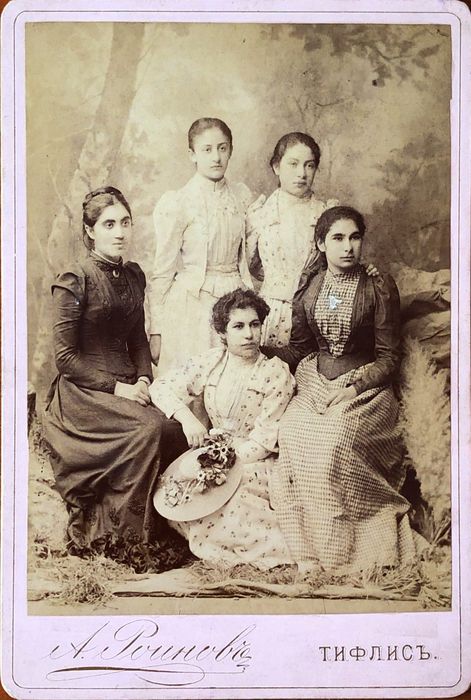
Margarit Babayan (bottom right), Shushanik Babayan (one standing behind Margarit), Armina Babayan (one in the middle) and two other girls in Tbilisi, 1890s.
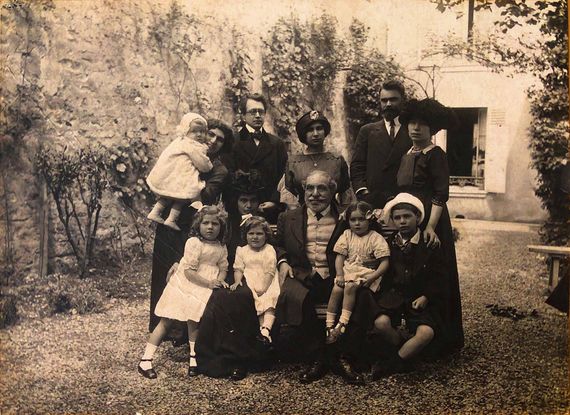
Margarit Babayan with her parents, sister, their husbands and children, Paris, presumably 1910s.
(bottom left Sofia Babayan, next to her Avetik Babayan, woman standing on the left Armina Babayan, her husband. one standing in the middle Margarit Babayan, one standing on the left Shushanik Babayan with her husband)
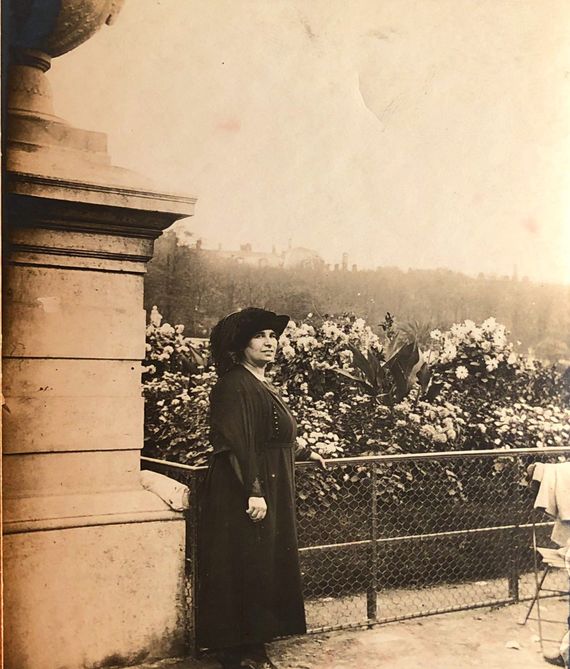
Margarit Babayan at Luxembourg Gardens, Paris, France.
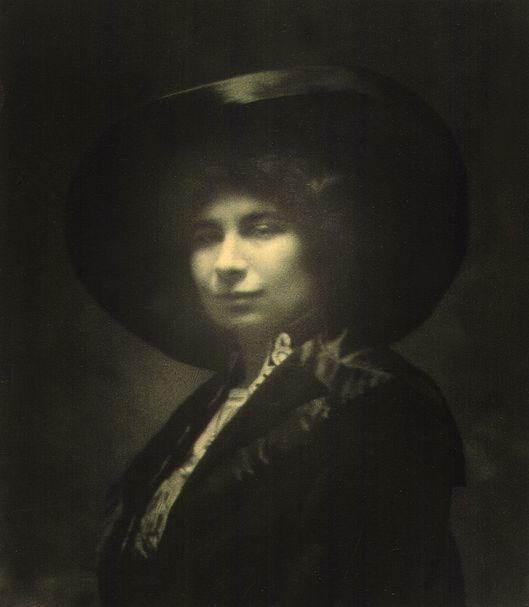
Margarit Babayan
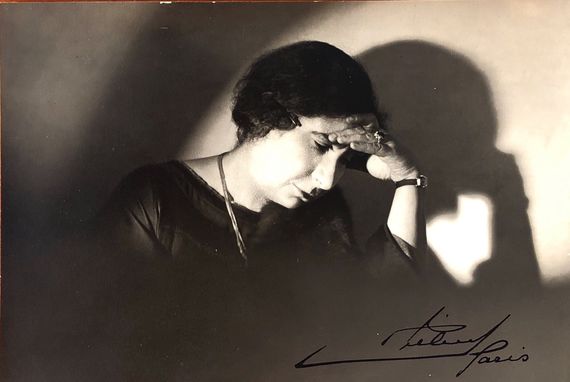
Margarit Babayan, photo with her signature.
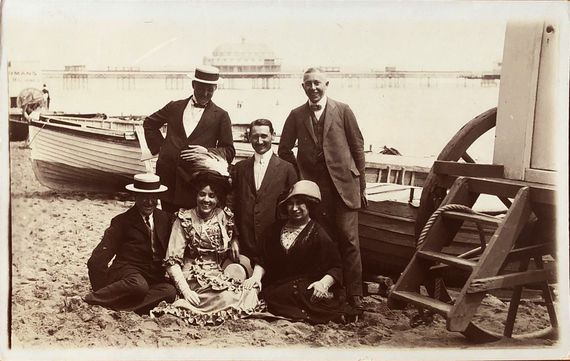
Margarit (one sitting on the right) with her friends in the Isle of Wight, 1912.
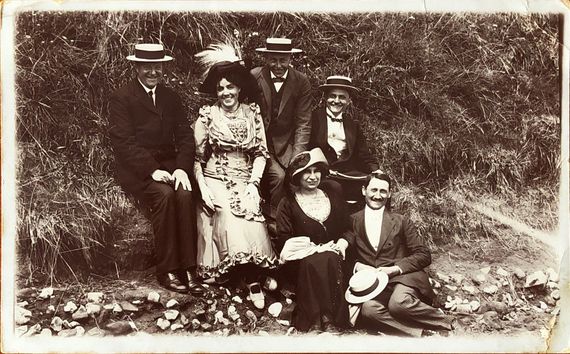
A postcard to Komitas Vardapet from Margarit Babayan (one sitting) from Isle of Wight a year after their holiday there, 1912.

The backside of the postcard:
“Dear Hayr Surbik, you may remember this woman who cried so much when listening to your songs. She asked me to send you her greetings and this wonderful photo. The other three young men are Czech teachers who stayed here for several days. And our first society here. The young lady sends many greetings.
With lovely greetings, yours Margarit Babayan.
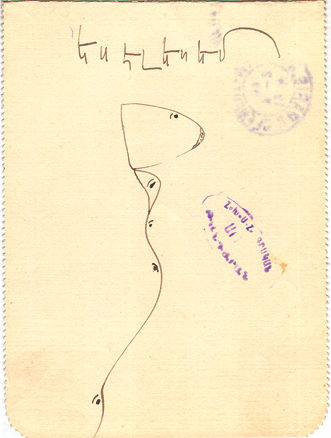
Komitas Vardapet used to attach sketches or write little poems in his letters to Margarit. This is one of his letters, written in a child's language, filled with humor. The drawing says “and this is me.”
Images courtesy of GAT (Yeghishe Charents Museum of Literature and Art).
from the same series
From the Forgotten Pages of History: The Resistance of Louise Aslanian
By Arpine Haroyan
From Tabriz to Paris, from resistance to a Nazi concentration camp...this is the story of Louise Aslanian, an Armenian woman whose convictions, commitment and words have largely been forgotten.
From the Forgotten Pages of History: The Life and Times of Mari Beylerian
By Arpine Haroyan
Western Armenian writer and editor Mari Beylerian perished during the 1915 Armenian Genocide. While there is scarce information about her life, she left behind the legacy of Ardemis, a monthly magazine published in Egypt and devoted to women’s rights.
From the Forgotten Pages of History: The Tragedy of Maro Alazan
By Arpine Haroyan
The four tragedies of Maro Alazan based on her unpublished memories- Genocide, Soviet prison, exile and return from exile. The untold story of an incredible woman and her resilience in life and love.



